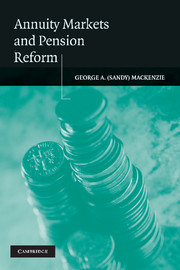Book contents
- Frontmatter
- Contents
- List of Tables
- Acknowledgments
- Introduction
- PART ONE
- 1 The Demand Side of the Annuity Market
- 2 The Supply Side of the Annuity Market
- 3 The Regulation of Annuity Providers
- 4 Experience with Individual Account Reforms
- PART TWO
- Appendix 1 The Economics and Financing of Annuities
- Appendix 2 Aging and Its Impact on Pension Systems
- Glosssary
- References
- Index
3 - The Regulation of Annuity Providers
Published online by Cambridge University Press: 13 November 2009
- Frontmatter
- Contents
- List of Tables
- Acknowledgments
- Introduction
- PART ONE
- 1 The Demand Side of the Annuity Market
- 2 The Supply Side of the Annuity Market
- 3 The Regulation of Annuity Providers
- 4 Experience with Individual Account Reforms
- PART TWO
- Appendix 1 The Economics and Financing of Annuities
- Appendix 2 Aging and Its Impact on Pension Systems
- Glosssary
- References
- Index
Summary
INTRODUCTION
In countries with established annuity markets like the United Kingdom and the United States, the annuity business is an integral part of the life insurance business, and it is not possible to isolate its operations from the other operations of the life insurance company. Consequently, the regulatory framework that applies to the life insurance business must also apply to annuities.
This chapter will survey the major regulatory issues that arise with the life insurance business in established markets. Most or all of these issues are relevant for countries with young annuities markets like Mexico and Hungary. However, there are obvious differences between the financial environments of the two groups of countries, and some regulatory issues are more important for the second group than the first. These issues are taken up in Chapter 4, in the discussion of the experience of individual accounts reform in Chile and other countries that have adopted a version of the Chilean model. This chapter begins by reviewing the rationale for regulation and the forms that regulation can take. It then describes the two standard approaches to regulation before turning to those aspects of life insurance regulation that are especially relevant for this study.
A word about the chapter's coverage of regulatory issues is in order. Financial regulation is a vast topic, even when it is restricted to the life insurance industry. The actuarial aspects of insurance regulation are particularly complex, and the literature on them is voluminous.
- Type
- Chapter
- Information
- Annuity Markets and Pension Reform , pp. 81 - 105Publisher: Cambridge University PressPrint publication year: 2006



